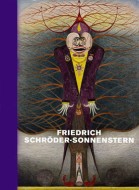Friedrich Schröder-Sonnenstern, essay by Pamela Kort. Michael Werner Gallery, 2011. ISBN: 978-1-8850-1381-1. Paperback $55
 Friedrich Schroder-Sonnenstern images of unexcelled symbolic intensity marked him as one of the most creative German artists of the mid-20th Century, but also an artist whose weirdly eroticized work was unlikely to be found on gallery walls in his own time. He was also hugely eccentric, putting in time as both a charlatan occultist and a mental patient, according to Pamela Kort’s essay in the recently published catalog for the exhibit From Barefoot Prophet to Avant-Garde Artist at Michael Werner Gallery in New York.
Friedrich Schroder-Sonnenstern images of unexcelled symbolic intensity marked him as one of the most creative German artists of the mid-20th Century, but also an artist whose weirdly eroticized work was unlikely to be found on gallery walls in his own time. He was also hugely eccentric, putting in time as both a charlatan occultist and a mental patient, according to Pamela Kort’s essay in the recently published catalog for the exhibit From Barefoot Prophet to Avant-Garde Artist at Michael Werner Gallery in New York.
His serious production of art began with no training and minimal preparation, resulting in an effusion of highly idiosyncratic pictures. Combined with his mental health history it could sound like a typical art brut biography, but the story does not necessarily conform to the usual script. Kort argues that his time in mental institutions should not be taken at face value. He was troubled, certainly, and eccentric, but not necessarily insane.
Indeed, Schroder-Sonnenstern was hardly an isolate who labored in obscurity. Early in his artistic career he participated in a local art discussion group. More importantly, his work was recognized and promoted by such luminaries such as Marcel Duchamp, Andre Breton and Hans Bellmer and exhibited in surrealistic shows. But Schroder-Sonnenstern’s art did not fit into the aesthetic conversation that dominated the post-war German art world, and he remained virtually unknown in his own country, according to Kort.
Kort devotes much attention to the artist’s medical history, but mostly to make thae case (a bit ironically) that his mental health should not be over-emphasized. Her view is that a focus on his purported schizophrenia only serves to marginalize his work, in his own time and ours, and that in any case may have reflected the man’s disrepute more than a real diagnosis.
If she spends a bit too much time assessing his mental state, in the process she provides plenty of interesting biographical details about a man whose life was in fact very interesting, art aside. In the years after World War I he was active as a mystic, clairvoyant and quack healer, although Kort does not think he had much belief in those callings. But this is a case where even the most fascinating biography pales in the context of the art itself.
His typically pulchritudinous figures appear in a variety more or less threatening scenes, with violence suggested or explicit but almost always understated. The titles are as cryptic as the symbols in the work – “The Moralistic Moon Dualism,” “Zynus Theory – whether Demon of Desiccation and Withering” and “The People’s Joyful Miraculous Shirt, or the Moralistic Scarecrow.”
Kort takes her best shot at interpreting the mind-bending symbolism, but it’s not easy. The complexity of her explanations, however admirable the effort, simply can’t keep pace with the art she is attempting to interpret.
The one thing that can be said clearly about this enigmatic artist is that his status as a true outsider is unshakable. Not because of anything about this personality or work but for the simple reason that he was twice refused membership in the Bildender Künstler Berlin, the Berlin Association of Visual Artists.
This review originally appeared in The Outsider, magazine of Intuit: The Center for Intuitive and Outsider Art.
